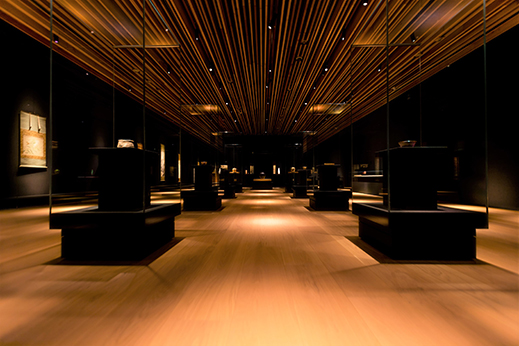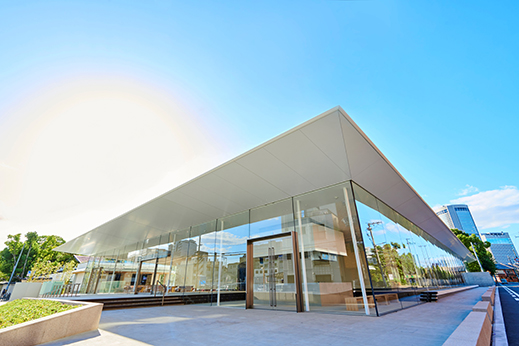 |
Focus features two in-depth reviews each month of fine art, architecture, and design exhibitions at art museums, galleries, and alternative spaces around Japan. |
|
|
 |
 |
 |
Back to the Future: A Museum Morphs from Meiji to Modernist
Colin Smith |
 |
Tea Bowl, Yohen Tenmoku, seen from above, is a National Treasure, as are the only two other tea bowls of its type in Japan. |
To see the universe in a tea bowl: this image, familiar from the intertwined worlds of Zen Buddhism and the tea ceremony, becomes remarkably literal when you gaze into Tea Bowl, Yohen Tenmoku, from Southern Song dynasty (12th-13th century) China, one of the stars of the Fujita Museum's collection. Tenmoku is the Japanese reading of Tianmu, a mountain in China where this style of tea bowl originated. Japanese Zen monks in training at the mountain's temples admired the contemplation-inducing randomness of the spotted glaze and brought some bowls back to Japan, the most prized of which were in the iridescent, blue-green mottled yohen tenmoku style. The character yo means "shining" or "star" -- hence its inclusion in the Japanese word for "day of the week," these being named after heavenly bodies. Heavenly is the word for the cosmic vista in miniature inside this cup. One of nine National Treasures in the Fujita collection, it mesmerizes with rainbows that shift (hen: change) according to the angle of view, as on oily puddles after rain -- a mundane analogy, but the chemical process at work may be similar.
 |
|
Everything old is new again: Wood from the museum's predecessor is used for the gallery floors. |
The same yo (—j) is also the title of one of three concurrent exhibitions now on view at the Fujita Museum, located in downtown Osaka. With the aforementioned tea bowl as a centerpiece, it features tea utensils and hanging scrolls of the type that often decorate tea room alcoves. Viewers are invited to compare the jet black of the Yohen Tenmoku bowl's base glaze with that of the ink used by monks to inscribe verse and Buddhist liturgy. All three exhibition sections have single-kanji titles, another one of which is Hana (‰Ô, flower), still in preparation as of this writing. The third is Den (™B, an older version of “` meaning convey, transmit). This is the first character of the given name of Baron Denzaburo Fujita (1841-1912), appropriately enough for a man who was dedicated to preserving the antique treasures of Japan and China and making them available to the public. The Den section focuses on the baron's personal taste in tea utensils, furniture, wall hangings and other items. Compare a rustic, lopsided, earth-toned tea bowl once owned by tea ceremony godfather Sen no Rikyu with the stellar radiance of the Yohen Tenmoku piece, or the fluid rivulets of the cursive Zaichuan Cover Letter with the orderly block script of the scrolls on display.
 |
|
Urban oasis: The garden next to the museum is open to the public free of charge. |
Denzaburo Fujita was born in 1841 in Hagi, in present-day Yamaguchi Prefecture, and made his way to Osaka after the Meiji Restoration of 1868. Maps of Osaka from the Meiji era (1868-1912) through World War II show that the area around what is now Osaka Castle Park was a sprawling hive of military activity and industry, and Fujita's first business ventures included selling munitions, shoes for troops, and other military supplies. He eventually got into railways, mining, textiles, construction and newspapers, built a manor by the Okawa River near Osaka Castle, and pursued a lifelong passion for traditional culture and arts. His estate had numerous tea rooms, a Noh stage, a strolling garden, and dozens of storehouses, only one of which survived World War II; this became the original Fujita Museum. While Meiji modernization was kind to Denzaburo and his sons Heitaro and Tokujiro (who carried on the collecting after his death), he worried that Japan was losing its soul as antiquities were neglected or destroyed and nativist sentiments heightened calls for Buddhism to be abolished. The Fujita family did not hoard one of the Kansai region's greatest art and antique collections for their own enjoyment, but were committed to sharing it with the people. Air raids destroyed almost the entire estate, but the Fujita Museum eventually opened its doors in 1954.
 |
|
Once tucked away in the garden, the museum is now a very visible presence in the Kyobashi neighborhood of Osaka. |
For years, the museum was one of Osaka's more hidden treasures. Shrouded by trees, in the depths of a garden ringed by high walls, a couple of decades ago it could not be located by a fresh-off-the-boat future Artscape Japan writer intrigued by the promise of a museum marked on maps and street signs. That has changed with its reopening, in April 2022, in a sleek modernist venue with glass walls announcing its presence to the street. The lovely Former Fujita Residence Garden, with a temple-style gate, pagoda, ponds and diverse plant life, remains unchanged and operates as a municipal park (open 10 a.m. to 4 p.m.). The rebuilt museum, however, is as cutting-edge inside as outside, though it retains its predecessor's DNA in floorboards made from remains of the storehouse and in imposing black iron doorways. While the exterior is a white cube, the galleries are black-walled and dimly spotlit, protecting the fragile works and independently showcasing each one. In many older museums, row after row of antique objects in glass cases can have a ho-hum effect no matter how remarkable each work might be, but the Fujita exhibits are well-spaced, dramatically lit, and not overabundant.
 |
|
 |
|
|
|
The museum café is an attraction in its own right. |
The old venue had its own charm, producing a sense that one had stumbled into a family treasure vault while its owners were absent, but the aging building could not be heated or cooled in a way that was safe for the exhibits, and it was only open during the all-too-brief temperate spring and autumn months. Its replacement is open every day of the year except the New Year holidays, and as a popular bonus, has a luminous café zone where tea is brewed and served tea-ceremony style with mini-dumplings freshly grilled on skewers.
Maki-e Sutra Box with Scenes of Buddhist Virtue (National Treasure). The crisp outlines around the lustrous, flowing shapes are produced by rubbing lacquer away from a shallow metallic relief underneath. |
Other highlights of the collection include an 11th-century maki-e (lacquer with metallic design) sutra box thought to have contained scrolls of the Lotus Sutra; a handscroll diary of Lady Murasaki Shikibu (author of The Tale of Genji); and portrayals of the Sixteen Arhats, eccentric Buddhist elders. With more than 2,000 works of East Asian (Japanese, Chinese and Korean) art and crafts -- painting, calligraphy, textiles, lacquerware, Buddhist art, tea utensils, textiles -- and a compact venue, the new incarnation of the Fujita Museum is in no danger of running short of material for rotating exhibitions like those now on view. The Baron and his sons would have been pleased.
Doors emblazoned with the family crest are a reminder of the Fujita family's heyday. |
All images courtesy of the Fujita Museum. |
 |
 |
Colin Smith
Colin Smith is a translator and writer and a long-term resident of Osaka. His published writing includes the travel guide Getting Around Kyoto and Nara (Tuttle, 2015), and his translations, primarily on Japanese art, have appeared in From Postwar to Postmodern: Art in Japan 1945-1989: Primary Documents (MoMA Primary Documents, 2012) and many museum and gallery publications in Japan. |
|
 |
|